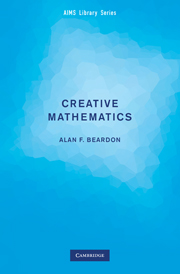4 - A First Look at the Problems
Published online by Cambridge University Press: 16 May 2024
Summary
Problem A: Circles and triangles
Before you read further, find a necessary and sufficient condition for three positive numbers L1, L2 and L3 to be the lengths of the sides of some triangle. Now justify your claim.
• Given a triangle in the plane, is it always possible to construct three circles, with their centres at the vertices of the triangle, such that each circle is tangential to each of the other circles? other, and the case where some of the circles lie inside another. If you give an algebraic solution then you must show that the radii are positive.
Problem B: Towers of positive integers
Consider a positive integer, say 4937. The numbers 4, 9, 3 and 7 are the digits of 4937, and 7 is the last digit of 4937. Now let x be any positive integer. The numbers x, x2, x3, … are the powers of x, and the numbers
are called the towers of x.
• Given that x ϵ ﹛1, 2, … , 9﹜, what is the sequence of last digits of the towers of x?
Normally, in a numerical problem, we consider each case, make some calculations, look for patterns, and obtain further evidence from a computer. We then make some conjectures and try to prove them. However, in this case, a few rough calculations show that the towers of x grow very rapidly.
• How many digits do 1010 and 101010 have?
The towers of x grow too rapidly to compute, so you may have to think a little more about this problem in order to make any progress. The last digit d of x satisfies x ≡ d (mod 10), so perhaps we can use congruences to reduce the numbers to a manageable size? This might mean that you need to learn more about congruences in order to solve this problem.
Problem C: Coloured discs
We are given n discs, where n ≥ 2, and each disc is either red or blue. We form the first pattern by placing the discs at equally spaced intervals around a circle.
- Type
- Chapter
- Information
- Creative MathematicsA Gateway to Research, pp. 19 - 26Publisher: Cambridge University PressPrint publication year: 2009



